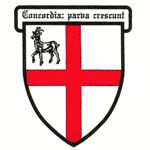
At least four, possibly more, forts were built by Sir Walter Ralegh's expeditions to the New World in the 1580s. The first expedition, under Philip Amadas and Arthur Barlowe, built nothing during their short visit to America in 1584, but the second, under Sir Richard Grenville, built three earthworks fortifications. Each of these three forts was built to defend the Englishmen from Spanish attack. In the spring of 1585, England had openly declared war against Spain by sending English troops to Continental Europe to aid the Protestant Dutch fighting to shake off the rule of Catholic Spain. America's first English colonists were very aware of the danger of attack from Spain's New World settlements. The first English fort was begun May 12, 1585, and abandoned May 23. Sir Richard Grenville fortified a beachhead at Allaboa Bay in Puerto Rico in order to build a pinnace (a small sailing vessel) and gather supplies ashore. This fort, depicted in one of John White's watercolors, enclosed a camp with huts and tents, a paddock, forge, swapit, and a makeshift boatyard. Simple pointed bastions and masked or hidden entrances interrupted the long, straight "curtain walls" of the fort. During the expedition's visit to Puerto Rico, Grenville sent his second in command, Ralph Lane, to capture and remove two Spanish salt mounds at Cape Rojos on May 26. Once the mounds were seized, Lane "intrenched himself upon the sandes immediately, compassing one of their (Spanish) salte hills within the trench." White's watercolor shows a basically square fort with three open bastions or points projecting from each of the three landward sides. The fourth side, the sea side, is broken by an entrance. Lane's men are shown hauling sacks of salt to a small ship's boat that has been pulled up on the beach at this entrance. Spanish troops approached Lane's work party, but these fortifications apparently frightened them off. Once the expedition reached Roanoke Island in the summer of 1585, the colonists under Lane built what he referred to as "the newe forte in Verginia." When this fort was excavated by National Park Service archeologist, J. C. Harrington in 1947-48, it was found to be strikingly similar to the one Lane built at Cape Rojos. The Roanoke Island fort also was a basic square with bastions projecting from three sides, but the entrances here were on the land side because the English held the land (island), whereas in Puerto Rico the entrance was on the waterside since the Spanish held the island. Two simple bastions face Roanoke Sound through which Spanish ships might have approached the colony. To the south, a round, horse-shoe-shaped bastion flanked the entrances. At least one, possibly two, small buildings were constructed inside the fort. These structures probably held the "gaol," military supplies, trade goods, and much of the food supply of the colony of 108 men. Lane's colony abandoned Roanoke and returned to England after eleven months. When John White's colony arrived year later in 1587, they found the earthworks of Lane's fort "rased down" or leveled, although the buildings still stood. White makes no reference to fortification during his short stay in 1587, but upon his return in 1590, he recorded a most intriguing discovery. On August 18, 1590, White found the settlement "strongly enclosed with a high palisade of great trees, with cortynes (curtain walls) and flankers (bastions) very fort-like." On one of the posts or trees of this palisade, he found carved the word "CROATOAN." The site of this palisade has never been identified with certainty. Some historians and archaeologists believe that a feature excavated near Lane's fort by Harrington in 1965 bears some similarity to later palisades built in Virginia in the early 1600's, and may be a part of this "palisado." Only further archeological research can prove whether this is the last of the forts of the Roanoke Voyages. Text by Phillip W. Evans |
Last updated: April 14, 2015
